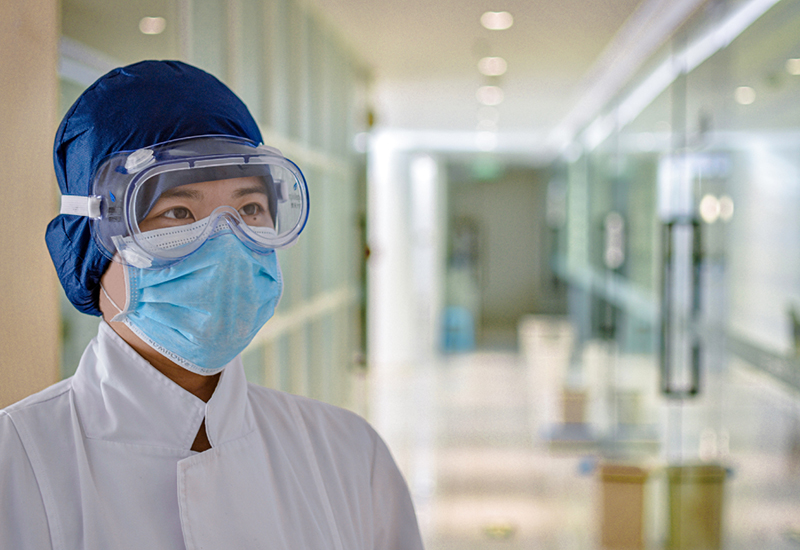Let’s support the supply lines that keep health workers safe from Covid-19
The production processes and supply chains that feed into the production of masks, gloves and other personal protective equipment must be secured.
The world faces an acute shortage of personal protective equipment as the Covid-19 pandemic spreads. Shortages of medical masks, protective suits, goggles, and gloves are putting the lives of frontline healthcare workers at risk. Panic buying, hoarding and misuse by the public are making the situation worse. Other essential medical devices, particularly ventilators used to support patients with severe respiratory conditions, are also in short supply.
| Asia is home to some of the world’s top producers of personal protective equipment for medical personnel. |
The World Health Organization (WHO) estimates that 89 million medical masks, 76 million examination gloves, and 1.6 million protective goggles are required for Covid-19 response each month. It recommends that industry increase manufacturing of this equipment by 40% to meet demand.
Managing the current supply chain to meet the surging demand is challenging. Many producers have already exceeded their surge capacity. Major disruptions to global supply chains and logistics due to stringent containment measures are also hobbling output.
Germany and the United States remain significant producers of face masks for their corresponding regions. But as the world’s largest producer of face masks, the People’s Republic of China plays a central role in producing and exporting masks to both Asia and the world. The pandemic forced the prolonged closure of all factories in the country through most of February. Although its mask production has been significantly revamped since then, exports continue to face disruptions due to quality controls and logistics costs.
The shortages go beyond face masks. Similar patterns are observed for protective gowns and goggles. The People’s Republic of China, Malaysia, and Thailand are the top three exporters of gloves. Manufacturers of other types of personal protective equipment that rely on raw materials or products from the People’s Republic of China have also been affected. Supplies are stagnating as distribution grinds to a halt. Transport and workforce constraints caused by roadblocks and quarantines and pandemic containment measures are affecting supply chains throughout the region, and indeed the world.
Surging demand for masks has also led to a shortage in its key component, nonwoven polypropylene, which is used to produce the fabric that filters out germs and droplets. An unanticipated increase in orders created a backlog in production of key materials and fabric assembly. Even when manufacturers install additional machines, it will take time. Reportedly, it takes at least 5-to-6 months to assemble a single machine production line to make the melt-blown fabric needed for the masks.
Even if factories could be geared up to meet demand, they still might not be able to get the equipment to the people who need it. More than 20 countries have instituted export bans, including major producers of personal protective equipment, most of which are based in Asia.
Concerted efforts both within and across borders should be made to boost production and open up exports while mobilizing available supplies more efficiently, mapping manufacturing facilities, and closely monitoring supply and demand.
All nations have been working hard to boost their production and distribution capacity for personal protective equipment. Many have tried innovative ways to immediately lift production by offering incentives to manufacturers. They are converting production lines from other manufacturing sectors, such as textile companies, to produce masks, gloves, and gowns, and relaxing regulatory restrictions. Guidance is being provided on the use of personal protective equipment to avoid wastage.
Beyond national efforts, concerted efforts are needed globally on multiple fronts to efficiently use personal protective equipment, boost its availability and strengthen personal protective equipment readiness.
What can be done?
First, better quality information about availability of products on the market, production capacity, and supply response is critical. It is important to improve transparency along the global supply chains, identify a list of critical components and their sources, and mobilize alternative sources and options.
A key challenge is the absence of a system-wide mechanism to track the amount of personal protective equipment circulating in markets and in use, as well as to centrally monitor the evolution of the supply and demand. An efficient, low-burden mechanism for governments and private sector partners to share situational and supply information should be developed.
Second, countries should work together to improve resource allocation and production capacity. Given the high cross-border interdependence, all nations will benefit from leaving doors open for trade in critical components and medical supplies and to streamline the cross-border freight logistics for these items. International cooperation is essential to provide secure supply chains and logistics, collectively estimate availability and capacity, and accelerate transportation across various of modes.
Third, surge capacity and trade logistics support need be prioritized. This includes addressing the cash flow constraints and trade restrictions facing manufacturers, which are often small and medium-sized enterprises. Financial assistance can be mobilized quickly to help them manage working capital shortages to hire workers and obtain the machines needed for production and distribution.
Finally, regional economies and institutions need to strengthen collaboration with established global mechanisms like the Pandemic Supply Chain Network coordinated by the WHO. As countries and regions face different infection curves at different times, efficient resource allocation on a global scale will help support individual countries by minimizing strains on limited domestic resources.
Frontline health workers need more masks, gloves and other vital equipment to keep themselves safe as they save lives. For this to happen, the production process and the vital supply chains that feed into it must be secured.
Cyn-Young Park is Director for Regional Cooperation and Integration, Economic Research and Regional Cooperation Department, ADB.
Kijin Kim is economist, Economic Research and Regional Cooperation Department, ADB.












